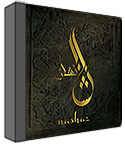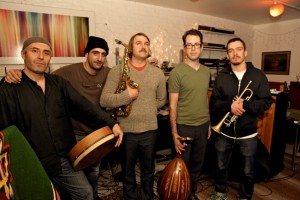 Artist: Nashaz
Artist: Nashaz
Title: Nashaz
Label: Ziryab Records
Genre: hard driving grooves in 10/8 and 7/8 combine with moments of contemplative beauty that sound at once Arabic, and yet distinctly American
Release date: September 17, 2013
CD release concert: at Drom (NY), September 17, 2013
Review by Dawoud Kringle
In the realm of Persian / Arabic maqam, people like Rabih Abou-Khalil and Simon Shaheen kicked open a door that once open, will never close. I speak, of course, of the introduction of elements of jazz into maqam. Nashaz has taken up the gauntlet on this and run with it.
 Nashaz is Brian Punka (oud), Kenny Warren (trumpet), Nathan Herrera (alto saxophone, alto flute, bass clarinet), Apostolos Sideris (bass), Vin Scialla (riq), and George Mel (percussion).
Nashaz is Brian Punka (oud), Kenny Warren (trumpet), Nathan Herrera (alto saxophone, alto flute, bass clarinet), Apostolos Sideris (bass), Vin Scialla (riq), and George Mel (percussion).
The first track, “Hijaz Nashaz,” begins by jumping into a very eastern composition. The improvisations are interesting. The oud is lyrical and poetic as if one is listening to an elderly man humorously impart words of hard earned wisdom. The trumpet’s musical exploration of the piece can best be described as conversational.
They continue with “Khartoum” with a bass line that begins as a watery flow and solidifies into a quasi-Moroccan groove. The oud and horns weave around each other like whirling wind. Toward the end, the horns lead the music out of its maqam environment into a jazz realm, and they walk away into the distance.
This would not be the first time the horns gently lead the music into the world of jazz. Yet, while they went quite a ways “out” on occasion, the integrity and inner meaning of the music never suffered.
Other pieces of the collection possess very interesting qualities. “Andalus” which is sad and melancholy, but not without optimism and hope. The trumpet solo, however, seems an introspection in to the cause of the sadness, rather than merely experiencing it; as if to say “I want to know why.” It fades in an indistinct and unresolved manner. “Qassabji’s Nightmare” was interesting in that the horns, veering into “jazz-land” seems to attempt to recreate the nightmare itself. “Al-Ghayb,” which means “The Unseen” an Islamic reference to the world / realm of the spirits, was particularly well suited to the title’s meaning.
The CD is very well produced. The sound of the oud is particularly beautiful; earthy, yet not dull, crisp and colourfully defined. The way it is mixed invokes a sense of space and dimension not unlike being in the room with the musicians. Recorded music is always hard pressed to create this illusion (as many people exploit the possibility within recording technology to create acoustic environments that cannot exist in nature.
One of the most obvious (or perhaps not obvious unless you look for it) facts is that none of these musicians are of Arab, Persian, or Turkish ancestry (although I’m guessing Sideris is Greek,,,). Yet there is an authenticity of this music that can only come with an intimate experience of its tradition and culture. An impressive accomplishment.

